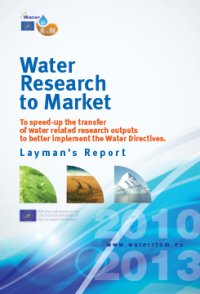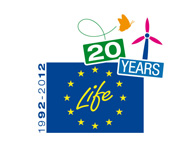GEOSAP
| Output characterisation | |
| OUTPUT SENTENCE | A geocomposite sorbing water to improve water availability for plants. |
| OUTPUT TYPE | prototype |
| WATER TOPIC | Quality of natural systems |
| MARKET NEED TAILORED | The idea of geocomposite sorbing water came up at the Wrocaw University of Environmental and Life Sciences, Institute of Environmental Engeneering, Poland, where the researchers for many years are interested in the problems of stabilization of the water conditioning vegetation of plants. The reason to begin research on water sorbing geocomposites was identification, by the World Health Organization, problems associated with a very alarming hydrological situation of the world. According to this lack of water threatens the lives and health of the inhabitants of 80 countries with a population of about 40% of the total population of the Earth. |
| OUTPUT DESCRIPTION | The project aims to create lasting technical capacity to retain rainwater in the soil available to plants for a longer possible to determine time. As a result of research work has been developed geocomposite, which thanks to its design is able to retain up to 90% of rain water. Water retained inside the geocomposite is progressively sorbed by plant roots. With the geocomposite in the cultivation reduces the consumption of water and fertilizers, and through continuous access to water is provided the optimal plant growth. Geocomposite reduces water stress in plants, increases the intensity of the development of root system and accelerates the development of shoots. The use of geocomposite allows to keep plants in good condition, even during drought or leave. Application: in the breeding pot plants and garden ; on slopes and embankments (road and rail) – it will have a positive impact on the vegetation, which is an element of insurance biotech grading of road and rail; on landfills; in the transport and storage of ornamental plants, tree seedlings, bushes, flowers; in urban areas - it will affect the solution to the problems related to the maintenance of urban green areas; in carrying out of forestation, especially in difficult habitat types; the redevelopment of degraded areas - it will contribute to the effective settlement of the energetic plant; in some areas of agriculture - mainly related to the conduct of multi-annual crops on lighter soils. |
| INNOVATIVE ASPECTS AND ADVANTAGES | Geocomposites absorbing water are an innovative combination of the two, known for years on the market - superabsorbents (hydrogels), and geosynthetics. It is a spatial element made of geosynthetic, where was placed inside the superabsorbent . At the moment of contact with water superabsorbent swells, closing in the middle of the geocomposite, the water in gel form. Located in the soil Geocomposite traps some of rainwater (water retention). Water Stored in the geocomposite is subsequently available for plants, allowing them faster and more efficient growth during the vegetation period and to survive in times of drought. Placing the superabsorbent in the "package" made of geotextile or other geosynthetic overcomes problems related with the use of superabsorbents in agriculture. Additionally Geocomposite can be placed precisely at the root of the plant, making it easier the use of stored water in it. Development of water sorbing geocomposite allows the use of superabsorbent in areas with a high slope: the erosion prevention of road embankments, flood banks , landfill embankments, etc. Previously, it was impossible or very risky. The use of geocomposite also allows the safe removal of the soil , eg in case of contamination. By its design, solves Geocomposite existing problems related to the use superabsorbents and provides new fields of application. The problems of water availability to plants found in many Polish regions, Europe and many other areas in Asia, Africa, Australia and the Americas. Develop new geocomposites sorbing rainwater, snowmelt or irrigation water that can be used by plants during the deficiency , provides a real chance to reduce this problem. |
| TRANSFERABILITY | Geocomposites absorbing water are an innovative combination of the two, known for years on the market - superabsorbents (hydrogels), and geosynthetics. It is a spatial element made of geosynthetic, where was placed inside the superabsorbent. At the moment of contact with water superabsorbent swells, closing in the middle of the geocomposite, the water in gel form. Located in the soil Geocomposite traps some of rainwater (water retention). Water Stored in the geocomposite is subsequently available for plants, allowing them faster and more efficient growth during the vegetation period and to survive in times of drought. Placing the superabsorbent in the "package" made of geotextile or other geosynthetic overcomes problems related with the use of superabsorbents in agriculture. Additionally Geocomposite can be placed precisely at the root of the plant, making it easier the use of stored water in it. Development of water sorbing geocomposite allows the use of superabsorbent in areas with a high slope: the erosion prevention of road embankments, flood banks , landfill embankments, etc. Previously, it was impossible or very risky. The use of geocomposite also allows the safe removal of the soil , eg in case of contamination. By its design, solves Geocomposite existing problems related to the use superabsorbents and provides new fields of application. The problems of water availability to plants found in many Polish regions, Europe and many other areas in Asia, Africa, Australia and the Americas. Develop new geocomposites sorbing rainwater, snowmelt or irrigation water that can be used by plants during the deficiency , provides a real chance to reduce this problem. |
| POTENTIAL USERS/CLIENTS |
|
| Estimation of risks | |
| INNOVATIVE DISADVANTAGE | The end of the project is planned for 4/30/2014. Was done: developed new forms of water geocomposites sorbing water adapted to different applications, conducted experiments with potted plants, bonsai trees, on slopes on green areas, in the cultivation of strawberries and raspberries, fruit trees, on degraded terrains. It remains to be done: continues surveying of the planned experiments. |
| Steps ahead | |
| TYPE OF PARTNER FOR THE NEXT DEVELOPMENTS | Not applicable |
| TASKS TO BE PERFORMED | Dissemination of the Project and output. |
| Estimation of ressources | |
| Contact | |
| TECHNICAL CONTACT | The GEOSAP Project Office: ; ?Uniwersytet Przyrodniczy we Wroc?awiu, Instytut In?ynierii ?rodowiska, ; ?Wroc?aw University of Environmental and Life Sciences, Institute of Environmental Engeneering ; ?pl. Grunwaldzki 24 p. 301M ; ?50-363 Wroc?aw; tel./f |
| COUNTRY | POLAND |
| WATER RTOM CONTACT | GWF |
| Background | |
| PROJECT NAME | WATER SORBING GEOCOMPOSITES - innovative technologies supporting plant vegetation |
| PROJECT ACRONYM | GEOSAP |
| PROJECT DESCRIPTION | The project aims to create lasting technical capacity to retain rainwater in the soil available to plants for a longer possible to determine time. As a result of research work has been developed geocomposite, which thanks to its design is able to retain up to 90% of rain water. Water retained inside the geocomposite is progressively sorbed by plant roots. With the geocomposite in the cultivation reduces the consumption of water and fertilizers, and through continuous access to water is provided the optimal plant growth. Geocomposite reduces water stress in plants, increases the intensity of the development of root system and accelerates the development of shoots. The use of geocomposite allows to keep plants in good condition, even during drought or leave. Application: in the breeding pot plants and garden ; on slopes and embankments (road and rail) – it will have a positive impact on the vegetation, which is an element of insurance biotech grading of road and rail; on landfills; in the transport and storage of ornamental plants, tree seedlings, bushes, flowers; in urban areas - it will affect the solution to the problems related to the maintenance of urban green areas; in carrying out of forestation, especially in difficult habitat types; the redevelopment of degraded areas - it will contribute to the effective settlement of the energetic plant; in some areas of agriculture - mainly related to the conduct of multi-annual crops on lighter soils |
| LEADER | Wroc?aw University of Environmental and Life Sciences, Poland |
| COUNTRIES INVOLVED | POLAND |
| PROJECT LOCATION | EU |
| FUNDING ORGANISATION | European Funds - Operational ProgrammeInnovative |




